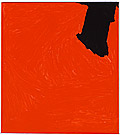Invisibility, Silence + Memory
Historical relationships of engagement between Indigenous and non-Indigenous Australians have been fraught with problems. The historical record, however, has been predominantly written by the coloniser, particularly on the frontier. What has emerged in the public arena is a skewed history—the black voice and discourse is missing.
Fiona Foley and Michael Cook remind us of the absence of an Indigenous perspective in the historical record. Their art speaks as a critique and repositions the voice of the author/authority; no longer is it a white history, but a black voice speaking to a white construct of history.
Mirdidingkingathi Juwarnda Sally Gabori’s vivid memories of family and Country are communicated in an emotive longing for a time past. Her paintings allude to the reality that she and many others in her community were removed from their Country by the coloniser, their historical connection severed and the control and governance over their own lives taken away. These paintings are both a testament of survival and a stoic reference to past injustices.
The evocative work of Vernon Ah Kee reminds us that history unfortunately has a way of repeating itself. Silence, invisibility, denial, injustice, oppression and misrepresentation of Aboriginal people in the public record still occur today. Ah Kee’s installation is a frightening look at black and white relations in Queensland.







